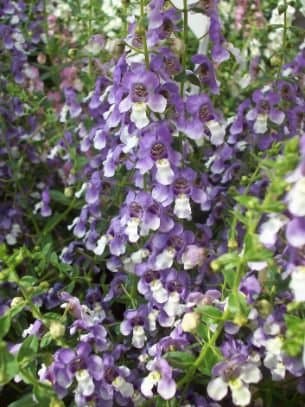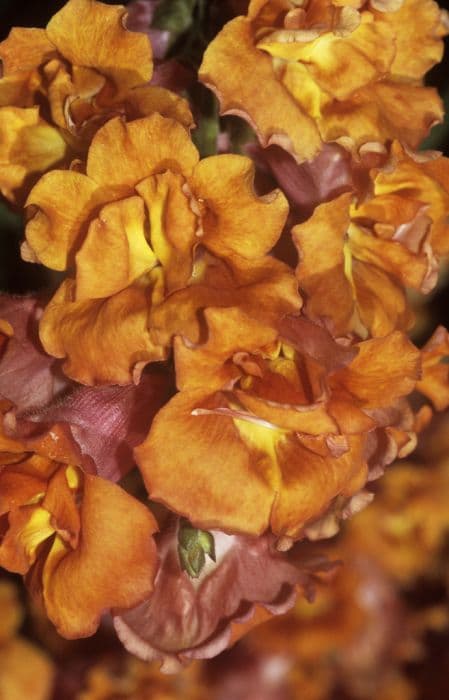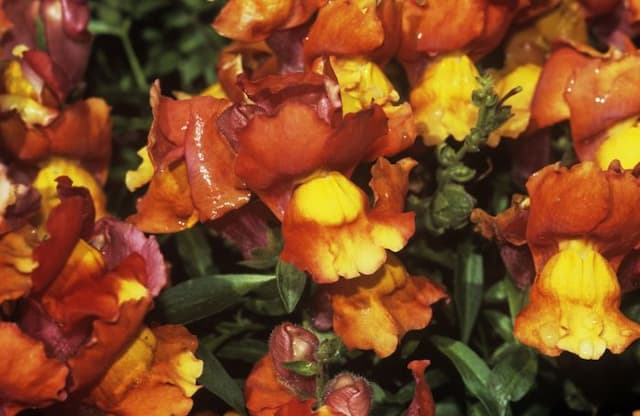Beardtongue Penstemon 'Bodnant'

ABOUT
Penstemon 'Bodnant' is a striking perennial plant known for its beautiful and showy flowers. The blossoms are one of its most distinctive features: tubular in shape, they typically appear in clusters on tall, slender spikes that rise above the foliage. The flowers can range in color, often seen in vivid shades such as pink, red, or purple, boasting a vibrant contrast that can easily become the centerpiece of any garden display. The foliage of Penstemon 'Bodnant' contributes to its overall attractiveness, with leaves that are narrow, lance-shaped, and sometimes exhibiting a glossy or semi-glossy texture. The leaves are often arranged in pairs along the stems, creating a neat and orderly appearance that complements the dramatic flowers. Overall, Penstemon 'Bodnant' has a habit that can be both erect and bushy, depending on how it is maintained, providing a lush, full look within a garden setting. The combination of its stunning floral display and its attractive foliage makes it a popular choice for gardeners looking to add a splash of color and elegance to their outdoor spaces.
About this plant
 Names
NamesFamily
Plantaginaceae.
Synonyms
Beardtongue, Bodnant Penstemon.
Common names
Penstemon 'Bodnant'
 Toxicity
ToxicityTo humans
Penstemon, also known as Beardtongue, is not commonly known for its toxicity to humans. There are no well-documented cases of Penstemon causing poisoning in humans, and it is generally considered non-toxic. Ingesting parts of this plant is not expected to cause significant symptoms or consequences. However, as with any plant material, individual allergies or sensitivities can occur, so it's always prudent to avoid ingesting plants not intended for human consumption.
To pets
Beardtongue is not known to be toxic to pets. There are no significant symptoms of poisoning associated with the ingestion of this plant by animals such as dogs and cats. It is generally considered safe around pets, but it's always wise to monitor your animals around plants and discourage them from eating ornamental plants to prevent any possible upset stomachs or allergic reactions.
 Characteristics
CharacteristicsLife cycle
Perennials
Foliage type
Deciduous
Color of leaves
Green
Flower color
Pink
Height
2-3 feet (60-90 cm)
Spread
2 feet (60 cm)
Plant type
Herb
Hardiness zones
6
Native area
North America
Benefits
 General Benefits
General Benefits- Attracts Pollinators: Penstemon 'Bodnant' is a favorite among hummingbirds, bees, and butterflies, which helps pollinate surrounding plants.
- Drought Tolerant: Once established, it is quite drought-resistant, requiring minimal watering and making it suitable for xeriscaping or dry environments.
- Low Maintenance: This plant generally requires little care beyond the occasional pruning to keep it tidy and promote more blooms.
- Long Blooming: Offers a long blooming period, providing color and interest in the garden from late spring through fall.
- Cold Hardy: It is capable of withstanding colder temperatures, making it suitable for gardens in cooler climates.
- Deer Resistant: Its foliage is typically not favored by deer, which can be beneficial in areas where deer browsing is a problem for gardeners.
- Ornamental Value: With its tubular flowers and attractive foliage, Penstemon 'Bodnant' adds aesthetic value to garden beds, borders, and containers.
- Erosion Control: Its root system helps to stabilize soil on slopes or in areas prone to erosion.
- Versatility: Can be used in a variety of garden designs, including rock gardens, alpine beds, and as a cut flower in floral arrangements.
 Medical Properties
Medical PropertiesThis plant is not used for medical purposes.
 Air-purifying Qualities
Air-purifying QualitiesThis plant is not specifically known for air purifying qualities.
 Other Uses
Other Uses- Penstemon 'Bodnant' can be used as a natural dye source; the blooms can impart subtle colors to fabrics and yarns.
- The flowers provide edible decoration for salads and desserts, but be sure to verify they haven't been treated with pesticides or other chemicals.
- This plant's strong stems can be used in the art of basket weaving to create patterns or to add structural strength.
- Pressed flower art is another unusual use for Penstemon 'Bodnant', as the flowers press well, maintaining color and shape.
- Ink making can be a unique application, with the flower's pigment providing a base for natural inks used in traditional calligraphy or art.
- Penstemon 'Bodnant' can be incorporated into educational activities to teach children about plant biology and pollinators due to their attractive flowers.
- The plant is used in photography to teach macro photography techniques, with its intricate flowers serving as a detailed subject.
- Gardeners can adopt companion planting with Penstemon 'Bodnant' to attract pollinators and beneficial insects to vegetable and fruit gardens.
- Craft enthusiasts may use the dried flowers in creating natural potpourris, combining them with other fragrant herbs and spices.
- Eco-printing is a process where plants are used to transfer their shapes and colors onto paper or fabric; Penstemon 'Bodnant' can contribute its distinct floral image.
Interesting Facts
 Feng Shui
Feng ShuiThe Penstemon is not used in Feng Shui practice.
 Zodiac Sign Compitability
Zodiac Sign CompitabilityThe Penstemon is not used in astrology practice.
 Plant Symbolism
Plant Symbolism- Boldness: The Penstemon 'Bodnant', also known as Beardtongue, often symbolizes boldness due to its vivid colors and prominent stamens that boldly project from its flowers.
- Diversity: Beardtongue comes in a variety of colors and forms, making it a symbol of the diversity found in nature and the beauty of different characteristics coming together.
- Health: In some traditions, the Penstemon is said to symbolize good health, perhaps due to its use in Native American herbal medicine for treating ailments.
- Attraction: With its bright flowers and ability to attract hummingbirds and bees, the Beardtongue can symbolize attraction and the power to draw others in.
 Water
WaterBeardtongue, commonly known as Penstemon 'Bodnant', requires moderate watering. During the growing season, it should be watered thoroughly once a week, ensuring the soil is moist but not waterlogged. Allow the top inch of soil to dry out slightly between waterings. In hot or windy weather, check moisture levels more frequently as the plant may need additional water. Be cautious to avoid overwatering. Provide the plant with approximately one gallon of water per week, adjusting based on rainfall, temperature, and soil conditions.
 Light
LightBeardtongue fares best in full sun to partial shade. Ideally, it should receive at least 6 to 8 hours of direct sunlight daily. A spot that gets morning sun and afternoon shade can be particularly beneficial in hot climates. The plant thrives in bright conditions, as too much shade can result in weak growth and fewer flowers.
 Temperature
TemperatureBeardtongue is suited to a wide range of temperatures but performs best in conditions that stay between 60°F and 70°F during the day. It can survive minimum temperatures down to 10°F but can be damaged by prolonged frosts and extreme cold. In the summer, it can tolerate heat up to 85°F, but care should be taken to avoid the stress of hotter temperatures.
 Pruning
PruningPrune Beardtongue in late winter or early spring to promote good form and healthy growth. Cut back the foliage to about 3 inches to encourage bushier growth and more abundant flowering. Pruning also helps to prevent fungal diseases by improving air circulation. Perform maintenance pruning to remove spent blooms and damaged stems throughout the growing season to keep the plant looking tidy.
 Cleaning
CleaningAs needed
 Soil
SoilBeardtongue prefers a well-draining soil mix with a slightly acidic to neutral pH of 5.5 to 7. Compose the mix using equal parts of loam, sand, and compost to ensure good drainage and fertility for optimal growth.
 Repotting
RepottingFor the 'Bodnant' beardtongue, repotting is generally not necessary as the plant is frequently grown as a perennial outdoor plant. However, if grown in containers, repot every 2-3 years to replenish soil nutrients.
 Humidity & Misting
Humidity & MistingThe 'Bodnant' beardtongue prefers average to low humidity levels typical of outdoor environments. It does not require any special humidity adjustments when cultivated in its natural outdoor setting.
 Suitable locations
Suitable locationsIndoor
Place Beardtongue in bright, indirect light indoors.
Outdoor
Plant Beardtongue in full sun to partial shade.
Hardiness zone
5-9 USDA
 Life cycle
Life cyclePenstemon 'Bodnant', commonly known as Beardtongue, begins its life cycle when its seeds germinate, typically in spring when soil temperatures warm up. The seedlings develop into young plants with a rosette of leaves at the soil level. As they mature, the plants form upright stems and produce lance-shaped leaves along these stems. By late spring or early summer, Penstemon 'Bodnant' reaches the flowering stage, presenting tall spikes adorned with bell-shaped flowers that are attractive to pollinators like bees and hummingbirds. After pollination, the flowers develop into capsules containing small seeds that disperse for the next generation. In the autumn, the plant begins to die back, though it is a perennial and will regrow from its root system the following spring.
 Propogation
PropogationPropogation time
Late spring to early summer
Penstemon 'Bodnant', more commonly known as Beardtongue, is often propagated by softwood cuttings. The most popular method involves taking cuttings from new growth in late spring or early summer, when the stems are just beginning to harden. Cut a 4 to 6-inch (approximately 10 to 15 cm) stem, making the cut just below a node, and remove the lower leaves. Dip the cut end in rooting hormone powder to encourage root development and plant it in a moist, well-draining potting mix. Cover the pot with a plastic bag or place it in a greenhouse to maintain high humidity and keep it in bright, indirect light. The cuttings usually root within a few weeks, after which they can be transplanted into individual pots or outdoor garden spaces.









